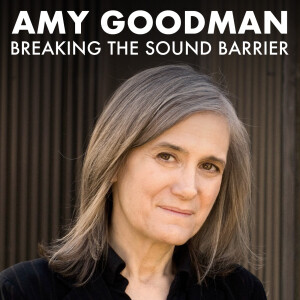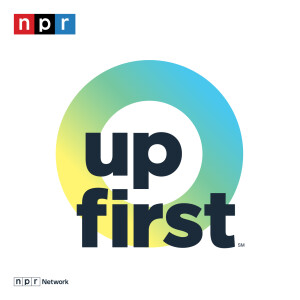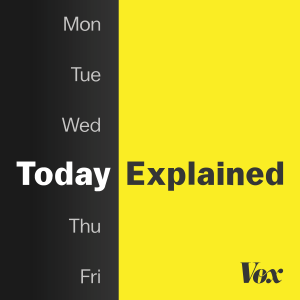

Breaking the Sound Barrier by Amy Goodman
https://www.democracynow.org/podcast-column.xmlEpisode List

From Thinking to Action in the Fight Against Plastics
By Amy Goodman & Denis Moynihan In Geneva, Switzerland’s Place des Nations, the plaza outside the United Nations campus, a replica of Auguste Rodin’s famous sculpture, The Thinker, has been installed. Like the original, the seated figure holds his chin in hand, but the hand in this version also clutches several empty plastic bottles. A baby lays across his other arm, resting its head in the Thinker’s left hand. The Thinker gazes down, past the baby, onto a sea of plastic waste that surrounds the statue. The statue’s placement coincides with a ten-day summit inside the UN, where negotiators hope to finalize the Global Plastics Treaty, an ambitious effort to reverse the overwhelming amount of plastic waste polluting the environment and negatively impacting human health in countless ways. Canadian artist Benjamin Von Wong calls his piece “The Thinker’s Burden.” “Over the course of the next 10 days, we’re going to be slowly adding more and more plastic to this art installation to show the growing cost being passed on to future generations if we don’t take urgent and immediate action,” Von Wong told Agence France Press as he added plastic to the pile. “If you want to protect health, then we need to think about the toxic chemicals that are entering our environment. We need to think about limits on plastic production. We need to think about a strong, ambitious plastics treaty.” The Global Plastics Treaty was supposed to be finalized last year at a summit in Busan, South Korea. Negotiations broke down between two major blocs of nations, those seeking controls on plastics and harmful chemicals, and nations with economies largely reliant on fossil fuel production, like Saudi Arabia, Iran and Russia. Since then, of course, US President Donald Trump began his second term, with his MAGA mantra of “Drill, Baby, Drill.” His appointees, like Energy Secretary Chris Wright, a former fracking company CEO, are shutting down climate programs, attacking climate science and promoting climate deniers to key policy positions. It is in this context that The Lancet, the premier British medical journal, has launched the Lancet Countdown on health and plastics, “a health-focused, indicator-based, global monitoring system on plastics,” with a global team of scientists led by Dr. Philip Landrigan, director of the Boston College’s Global Observatory on Planetary Health. “The global plastic threat has been quietly worsening; global plastic production has increased 250 times since it began in the 1950s and as it’s on track to double by 2040, and triple by 2060,” Landrigan said on the Democracy Now! news hour. “The reason plastic production is growing so rapidly, especially production of single use plastics, is the fossil fuel industry. Ninety-nine percent of plastic is made from oil, gas and coal. They see the market for fossil fuels declining…they see the long term trend for the fossil fuel market going down, so they’re putting enormous resources into plastic.” Dr. Landrigan continued, “Plastic harms human health at every stage of the plastic life cycle, starting with the fracking and through the manufacturer and the fabrication of plastic products, and finally, when plastic is discharged into the environment. Waste plastic contains 1000s of toxic chemicals that cause human exposure that result in disease, disability and premature death.” The Lancet group released a comprehensive report with their announcement, detailing the scale of the problem. Plastic pollution has been found from the deepest ocean depths to the slopes of Mount Everest. Plastic nanoparticles infiltrate the human body, from the brain to breast milk. The impacts on children are the most severe, Landrigan said: “Infants in the womb and young children are very vulnerable to plastics…chemicals get out of plastics, get into pregnant women and then pass through to their children, and in children they can cause a whole range of diseases that encompass brain injury, resulting in decreased IQ, injury to the reproductive organs, resulting in decreased fertility when today’s child becomes tomorrow’s adult, and damage to the liver, which interferes with cholesterol metabolism and increases risk for obesity, for diabetes, for heart disease and stroke.” Auguste Rodin sculpted The Thinker between 1880-1881, less than 20 years after plastic was invented in England. Rodin intended the sculpture to be part of a larger, epic piece called “The Gates of Hell,” inspired by Dante’s Inferno. “The Gates of Hell” consumed much of Rodin’s life, and was only cast after his death. His pensive Thinker, meanwhile, went on to achieve global renown on its own. We are now at a moment where life truly is imitating art; the fossil fuel industry is driving us into an inferno, accelerating the climate catastrophe and blocking meaningful action on climate and on the Global Plastics Treaty. We are standing at a real-world version of Rodin’s Gates of Hell, where thinking about the problem is no longer enough.

The Education of Sereen Haddad
By Amy Goodman & Denis Moynihan “Never let your schooling get in the way of your education,” is a quote attributed to Mark Twain or a contemporary of his, the writer Grant Allen. The point has been displayed across college campuses over the past almost two years, as students mounted protests in solidarity with Palestinians, met with often violent crackdowns by campus authorities, police and vigilantes. One striking example of the suppression of dissent occurred at Virginia Commonwealth University, a public research university in Richmond, Virginia. On Monday, April 29, 2024, students gathered outside Cabell Library, protesting U.S. support for Israel’s attack on Gaza. Sereen Haddad, a Palestinian American student, was one of the organizers. Her father, Dr. Tariq Haddad, is a Virginia cardiologist who grew up in Gaza. Two months earlier, he had been invited to a roundtable meeting with then-Secretary of State Antony Blinken. He explained his refusal to attend, breaking down as he spoke on the Democracy Now! news hour: “Some context is necessary here to understand why I turned this invitation down. I have hundreds of family members in Gaza, both sides of my family, in the town of Khan Younis and Gaza City. I’ve had about a hundred family members at this point who have been killed, including physicians, pharmacists, lawyers, engineers, dozens and dozens of children, multiple small babies…My cousin Jamal El-Farra, his son, who is a physician, Dr. Tawfiq El-Farra, his wife who was pregnant, two of their beautiful daughters, Reem and Hala, Jamal’s brother Esam, wife Semad, and their daughters, Rusul, Tuqa and Nadian, multiple generations all killed…” Dr. Haddad continued to recite the names of family members killed. Now, 18 months later, the number is over 200. Sereen recalled the day of the VCU protest, speaking recently on Democracy Now!: “Many people at Virginia Commonwealth University set up an encampment to pressure the university to divest from death and divest from Israel. Instead of being supportive, instead of hearing the students out and understanding that students were there because they did not want their tuition dollars, our tuition dollars, going to killing our people and my family, what they did is send three different police forces that night to come and brutalize us.” Thirteen students were arrested. Sereen, bloodied and bruised, was not charged. If they were guilty of anything, it would have been for taking the university at its word. Proudly emblazoned on VCU’s website is the phrase, “Unafraid to challenge the status quo.” Indeed, VCU President Michael Rao, in his 2023 state of the university speech, said, “At VCU, we have not been known to follow the status quo because we don’t. We’re here to transform students’ lives … to help them with the many others that they’re concerned about. I love this generation. They love other human beings.” It was a strange way to show love for the students, with pepper spray, tear gas and police. This April, Sereen and about 40 other students gathered on the anniversary of the protest. One observer likened the peaceful assembly to a picnic. Once again, it was broken up by police. Sereen was targeted as an organizer and, along with another student, was told that VCU would withhold their diplomas. She was a stellar student, completing her four-year psychology degree in three years. “They were requiring me to take a class on morals and ethics,” Sereen said. “I don’t need the validation from a university that is materially invested in the killing of children, in the killing of thousands of people, to get my degree. I don’t need the validation from them to tell me that I need to take a class on morals and ethics. … I understand that I’m on the right side of history.” Sereen appealed the withholding of her diploma, and this week, 82 days later, she won. She responded on Democracy Now!: “This was not VCU choosing to do the right thing or waking up and realizing that they made an error. This was the result of pressure on a case that they could not defend. It was the result of truth prevailing, and they were left with no choice because the truth was always on our side. I cannot separate this small victory from the reality that at this very same moment millions of Palestinians are being starved in Gaza intentionally, systematically and with the support of the very systems that tried to silence me. The fact that I had to fight for my own diploma, something that I rightfully earned, is a testament to the exact same systems that are upholding and enabling genocide.” Sereen Haddad has finally won her degree. More importantly, this talented young graduate, in challenging starvation and genocide in Gaza, has gotten an education. Instead of being forced to take a class in ethics and morals, she could teach one.

From the Warsaw Ghetto to Gaza, Starvation as a Weapon of War
By Amy Goodman & Denis Moynihan In 1516, a 7-acre section of Venice, Italy was designated as the area where Jews would be required to live. As it was located where a copper foundry had been, it was called by the word for ‘foundry’ in the Venetian dialect, “geto.” The practice of forcibly concentrating Jews into such “ghettos” grew, reaching a brutal, murderous climax under the Nazi regime in the 1930s and 40s. The Nazis built hundreds of ghettos in cities they occupied, creating a system of oppression that, for most Jews, led to death on the street, or deportation to death camps like Treblinka. The Warsaw ghetto was the most notorious Nazi ghetto. Germany invaded Poland on September 1st, 1939, and within a year had constructed the walled ghetto. Close to half a million Jews were imprisoned there. Those who attempted to escape were shot on sight. Germany immediately restricted food and medicine, leading to starvation and disease. Images of the desperation were actually filmed by Nazi propagandists. Four reels of silent film footage were found in East Germany years after the war. It appears in the 2010 documentary, “A Film Unfinished.” The footage juxtaposes fabricated scenes of wealthy Warsaw Jews enjoying comfortable lives while outside people dressed in rags beg and others collect the dead from the street. The propaganda film was never completed, hence the documentary’s title, but the images of suffering provide a rare look at the inhumanity of the Nazi ghetto. That was 1942. Now, in 2025, there is another embattled enclave where people of one ethnicity are imprisoned, dying of starvation and disease, shot on sight if they try to escape. This is Gaza, a manufactured hell on Earth that can only be described as a ghetto. This comparison is not new. Two months after Hamas’ October 7, 2023 surprise attack on Israel, The New Yorker published an essay by M. Gessen, titled, “In the Shadow of the Holocaust.” In it, Gessen makes the comparison between Jewish ghettos under the Nazis and conditions in Gaza. Explaining the point on the Democracy Now! news hour at the time, Gessen said, “The similarities are so substantial that they can actually inform our understanding. What’s happening now is that the ghetto is being liquidated. That’s important to say, not just because it’s important to describe things in the best possible way that we can, but because, again, in the name of ‘never again,’ we have to ask if this is like a ghetto. If what we’re witnessing now in this indiscriminate killing, in an onslaught that has displaced almost all the people of Gaza, that has made them homeless, if that is substantially similar to what we saw in some places during the Holocaust, then what is the world going to do about it? What is the world going to do in the name of ‘never again?’” Israeli-American scholar Omer Bartov, Brown University professor of Holocaust and Genocide Studies, told Democracy Now! of the increasing consensus among academics that Israel’s attack on Gaza amounts to genocide. He described Israel’s plan to build a “humanitarian city” to house 600,000 Palestinians there as “a sort of combination of ghetto and concentration camp, that would be built on the ruins of Rafah…this is extraordinary. The state of Israel publicly is speaking about the creation of a vast concentration camp whose goal is removal of the population.” Well over 100 Palestinians in Gaza have starved to death, and counting. Michael Fakhri, U.N. special rapporteur on the right to food, said on Democracy Now!, “This is the fastest famine we’ve seen, the fastest starvation campaign we’ve seen in modern history.” The UN’s aid distribution has been essentially shut down, replaced with the shadowy US and Israeli-backed so-called Gaza Humanitarian Foundation. Palestinians swarm the inadequate sites seeking food; over 1,000 have been killed there so far, fired upon by the Israeli military and US mercenaries. Mahmoud Alsaqqa, Oxfam’s emergency food security lead in Gaza, appeared on Democracy Now!, having himself lost over 30 pounds during Israel’s war on Gaza. “This is happening in front of all the world,” he said. “All the world is watching this heartbreaking, without taking concrete action.” The Warsaw Ghetto’s Jews launched an uprising, temporarily halting the death camp deportations. By mid-1943, the uprising had been crushed, the remaining ghetto residents killed. Monuments to the ghetto and the uprising dot Warsaw now. President Donald Trump and Israeli Prime Minister Benjamin Netanyahu want all Palestinians removed from Gaza, in what would be a criminal act of mass ethnic cleansing. Trump wants the US to own Gaza, and build what he calls “the Riviera of the Middle East.” There are more than two million Palestinians in the Gaza ghetto, now more than ever in need of food, aid, solidarity and action from us all.

Trinity, 80 Years Later, Still Threatens a "Hard Rain's a-Gonna Fall"
By Amy Goodman & Denis Moynihan July 16 marked the 80th anniversary of the first atomic bomb explosion, at what the bomb’s creator, physicist J. Robert Oppenheimer, called the Trinity Site in New Mexico. The harsh desert terrain had been known for centuries by the name given by the Spanish conquistadors, the Jornada del Muerto, the Journey of Death. The Trinity test was followed by the first and to date only wartime uses of atomic weapons, when the U.S. dropped bombs on the Japanese cities of Hiroshima and Nagasaki, on August 6th and 9th, respectively. Over 210,000 people were killed in the blasts, almost all of them civilians. Years later, Oppenheimer reflected on Trinity during an interview with NBC News: “We knew the world would not be the same. A few people laughed; a few people cried. Most people were silent. I remembered the line from the Hindu scripture, the Bhagavad Gita; Vishnu is trying to persuade the prince that he should do his duty, and to impress him, takes on his multiarmed form and says, ‘Now I am become Death, the destroyer of worlds.’ I suppose we all thought that, one way or another.” Nuclear weapons have not been used in war since 1945, although there have been close calls. Just last month, former Russian President Dmitry Medvedev threatened to use tactical nuclear weapons on Ukraine. In his first term, President Donald Trump suggested a nuclear attack on North Korea when he threatened the nuclear-armed country with “fire and fury.” Historians generally agree that the closest we’ve come to nuclear war was the Cuban missile crisis in October 1962, the height of the Cold War between the U.S. and the Soviet Union. The U.S. had placed nuclear missiles in Turkey and Italy, threatening the Soviets, who responded by deploying nuclear missiles in Cuba. President John F. Kennedy imposed a naval blockade on Cuba, engaging in a high stakes military confrontation with the Soviet Union that could have rapidly escalated into nuclear war. In the end, diplomacy worked, and the missiles were removed from Cuba and from Italy and Turkey. Months after the crisis, 22-year-old musician Bob Dylan released an album that included the song, “A Hard Rain’s a-Gonna Fall,” which resonated with his audience who heard a metaphorical connection between “hard rain” and the omnipresent risk of lethal nuclear fallout. More than 60 years later, on this 80th anniversary of the Trinity blast, the song took center stage at a remarkable gathering in Chicago. The Nobel Laureate Assembly for the Prevention of Nuclear War was organized by the Bulletin of the Atomic Scientists to address “the high and seemingly rising prospect of nuclear war.” About 20 Nobel laureates and 60 leading nuclear experts convened for three days to provide policy recommendations and actions for leaders and the public to take to reduce the risk of nuclear annihilation. The conference ended with a performance of Nobel Laureate Bob Dylan’s “Hard Rain” by the Kronos Quartet and The Hard Rain Collective, a group of musicians assembled by Kronos that included Ringo Starr, Iggy Pop, Allison Russell, Willie Nelson, Laurie Anderson, and dozens more. Speaking on the Democracy Now! news hour on July 16, the Trinity test anniversary, David Harrington, violinist, and founder and artistic director of the Kronos Quartet, explained, “If music and musicians can step up and project those kinds of concerns about all of our futures, then music is doing its job. What we need to do as musicians is listen. When I listen to what’s happening in the world, it’s terrifying, and I want my musical community to do something about it. This is our first step.” Daniel Holz, a University of Chicago astrophysicist and chair of the Bulletin’s Science and Security Board, was one of the conference organizers and appeared with Harrington on Democracy Now! Holz said, “Trinity was sort of the birth of a new age, the age of nuclear weapons, and we’re still in that age. The threats that people recognize, that Oppenheimer’s quote captures, they’re still with us. We now have thousands of these weapons. They’re on high alert. They can go off at any moment. Within an hour, civilization could end. That’s still where we are now.” The Nobel assembly released a declaration on the Trinity anniversary this week that included a “call on scientists, academics, civil society, and communities of faith to help create the necessary pressure on global leaders to implement nuclear risk reduction measures.” A new arms race is heating up. President Trump plans a technically impossible “Golden Dome” missile defense system over the U.S. Meanwhile, by joining Israel in its attack on Iran, Trump has encouraged Iran to pursue its own nuclear deterrent. What Oppenheimer and the secret, U.S. government’s Manhattan Project unleashed in 1945, only a mass, organized peace movement can contain.

The Guadalupe River Flood: Blame the Climate Catastrophe
By Amy Goodman & Denis Moynihan The Guadalupe River in Texas gets its name, according to one popular etymology, from the Arabic phrase, “wādī al-lubb,” meaning “hidden river.” In the early hours of July 4th, though, the river was anything but hidden. Intense rains caused a flash flood in the middle of the night, transforming the typically quiet river into raging torrent, rising more than 30 feet over its normal level. As the flood waters cascaded out of the Texas Hill Country, it left a path of death and destruction in its wake. As this goes to press, there are 120 confirmed deaths, and over 150 people still missing. One of the first population centers to be devastated was Camp Mystic, a storied institution founded in 1926 that hosted generations of girls from Texas’ elite families. There were reportedly upwards of 750 campers, counselors and staff present when the floodwaters crashed into the camp sometime after 3 am. Cabins for the youngest campers, the eight year-olds, were closest to the river. Older campers stayed on slightly higher ground. When a wall of water 30 feet high crashes down, elevation matters. Many of the campers who died were the youngest, torn from their bunks, dragged downriver in the darkness. The flood next hit the towns of Hunt and Ingram before reaching Kerrville, destroying homes, RV parks, trees, bridges, cars and anything else in its path. As dawn broke on the 4th of July, rescue teams began reaching impacted areas. Hundreds of people were rescued from the floodwaters, but no survivors have been found since last Friday, July 4th. Thousands of people have been scouring the debris left in the flood’s wake, searching for the bodies of victims. While rescue and recovery activities proceeded, efforts to understand how this disaster happened have begun. The core of early warning for floods like this are the weather forecasting professionals at the National Weather Service, a department within NOAA, the National Oceanic and Atmospheric Administration. President Trump has gutted NOAA since taking office last January. Despite the job cuts, the NWS was able to alert local officials about likely flooding. Kerr County’s top elected official, Judge Rob Kelly, admitted, “We do not have a warning system.” Climate science has long acknowledged individual extreme weather events can’t be directly attributed to global heating, but that the worsening climate definitely causes more intense storms and droughts and causes them more frequently. The devastating flooding of the Guadalupe River is a case in point. The region had been in drought recently, which hardens the ground, intensifying the runoff from rainstorms. The disaster occurred on the same day, July 4th, that President Trump signed the so-called “Big Beautiful Bill,” the budget reconciliation bill. “You started with the Texas floods. We know that the climate crisis kills,” award-winning investigative journalist Antonia Juhasz said on the Democracy Now! news hour, commenting on the impact of the new budget law. “We also know that we have remedies: cut fossil fuels, transition to localized renewable energy and support frontline communities. Those programs have essentially been erased, to the best extent that they could, in this tax bill to remove tax incentives that would help us support solar and wind energy manufacturing. Tax breaks for consumers, producers, those were entirely stripped away to cut out that financial support for the solar and wind transition. Tax breaks, billions of them, to the fossil fuel industry. And remember, this bill extends all of those tax cuts from 2017, which had already brought billions of dollars to the fossil fuel industry, and just gives them new benefits.” Trump’s attack on climate action will intensify the global climate catastrophe, accelerating fossil fuel drilling and burning, essentially guaranteeing more deadly extreme weather events will happen in the future. Texas is especially susceptible to climate impacts. On the day before the Guadalupe flood, The Texas Observer, one of the state’s most respected investigative news outlets, published a piece by MIT management professor emeritus Henry D. Jacoby, headlined, “Trump’s DOGE Cuts Are a Texas-Sized Disaster.” In it, Jacoby writes, “Federal resources for managing climate-augmented weather disasters are being wiped out, and crucial information about future risks is being destroyed or degraded. Meanwhile, state leaders stand by while denying the seriousness of climate change as a driver of these events—and the threat this poses to the state economy.” Texas Governor Greg Abbott, while ignoring the role the worsening climate catastrophe is playing in the disaster that just hit Kerrville, he understands politics. To that end, he just summoned the Texas legislature back for a special session. Leading the agenda are action items to address the state’s failure to prepare for the Guadalupe flood. But, top of the agenda for Texas and the entire country should be the worsening climate catastrophe. Ignore that, and more severe and unpredictable weather events will only become more routine…and more deadly.
Create Your Podcast In Minutes
- Full-featured podcast site
- Unlimited storage and bandwidth
- Comprehensive podcast stats
- Distribute to Apple Podcasts, Spotify, and more
- Make money with your podcast












